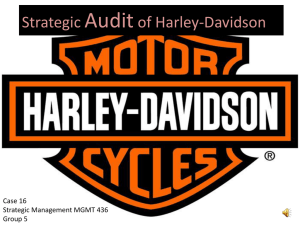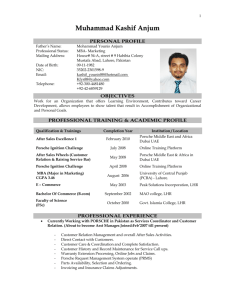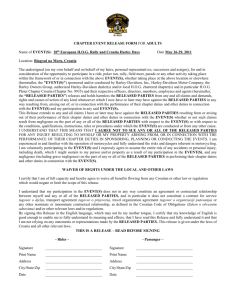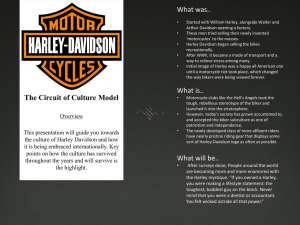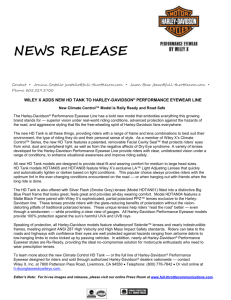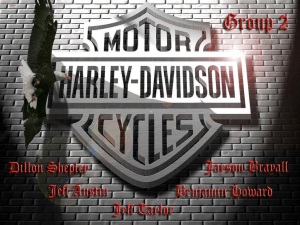the strategic drivers of the 'revolution': harley
advertisement
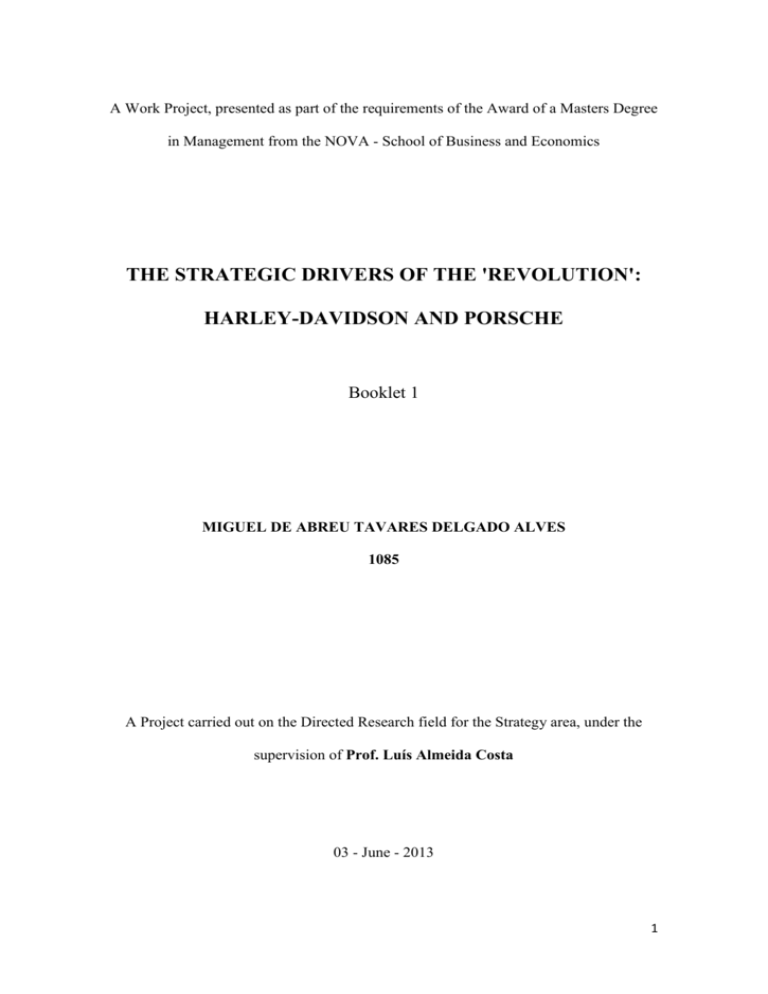
A Work Project, presented as part of the requirements of the Award of a Masters Degree in Management from the NOVA - School of Business and Economics THE STRATEGIC DRIVERS OF THE 'REVOLUTION': HARLEY-DAVIDSON AND PORSCHE Booklet 1 MIGUEL DE ABREU TAVARES DELGADO ALVES 1085 A Project carried out on the Directed Research field for the Strategy area, under the supervision of Prof. Luís Almeida Costa 03 - June - 2013 1 Abstract This work project's main objective is to identify the motivations behind the strategic alliance between Harley-Davidson and Porsche. In that sense, this paper includes a case study on the specific context of that collaboration and a literature review as the basis of its analysis. As a result, the major conclusion was that the drivers of that alliance indeed agreed with the general theories on the matter. Factors as venturing on new segments of the market or having access to unique resources worked in favor of this partnership, as Harley's new engine and motorcycle proved to be a global success. Keywords: Harley-Davidson, Porsche, strategic alliance, motivations Acknowledgements As a remark, I would like to express the most genuine gratitude to my supervisor Prof. Luís Almeida Costa for his orientation and constructive criticism throughout the length of this work project. His encouragement and guidance were definitely essential for the development and conclusion of such task. I would also like to acknowledge the openness and collaboration of Dr. Manuel José Olaio, the head representative of Harley-Davidson in Portugal. I am thankful for his helping hand, as he was an important source of information especially for the case study. Last but not least, my family and friends must also be considered in this section for their support and motivation, which were also very helpful for the success of this project. 2 Purpose of Project It is the purpose of this project to give the reader a deep insight on the motivations that take firms to engage in strategic alliances. It is my objective to extensively explain, based on a practical example, the reasons why two companies looked at this type of venture as a solution to various business issues. This project will take the form of a case study as a way to thoroughly analyze, in this situation, why did Harley-Davidson build a partnership with German automobile service provider Porsche for the development of a brand new motorcycle engine and in what conditions it happened. This collaboration started in the final years of the 20th century and consisted in a major strategic decision especially for the Wisconsin-based firm, as it represented a drastic departure from the regular methodologies employed since its early ages. This work project will be divided into three distinct parts. Firstly, the case description will be used to study in detail the whole background of the alliance itself. I will focus on the American motorcycle manufacturer's perspective of it, and for that I will rely on the contacts made with Dr. Manuel José Olaio, head representative of Harley-Davidson in Portugal, apart from other general sources. Yet, Porsche's position will obviously not be neglected - my mission is to provide a clear comprehension of this specific strategic maneuver, so understanding both sides is important to reach a conclusion. Secondly, I will make use of a brief literature review to give the reader a theoretical perspective on the topic of strategic alliances and the motives for its formation, which is essential to make an extensive analysis of the practical example. Accordingly, this last part will be the basis for the third and final chapter, where the case's relevant issues will be applied to the theoretical approach to reach a settling conclusion on the matter. As a reference, I also provide a separate booklet of appendices with extra information. 3 "The strategic drivers of the 'Revolution'" "We fulfill dreams inspired by the many roads of the world by providing remarkable motorcycles and extraordinary customer experiences. We fuel the passion for freedom in our customers to express their own identity"1 - Harley-Davidson's Vision Statement Jeff Bleustein sat baffled in his office at the end of one more hard working day. The recently appointed CEO of Harley-Davidson Inc. knew he had a lot to look forward to, as the major American motorcycle manufacturer was facing the turn to a new millennium with record breaking sales and the regained worldwide leadership on the heavyweight market. However, something had been troubling his mind for quite some time. Earlier that week, he had met the Chief Styling Officer Willie G. Davidson in that very same office to review the most recent developments of the top-secret P4 Project. The conclusions were clear - the projected motorbike would definitely need to be built under a completely new framework and design in order to fit the innovative power and technology requirements. This, of course, represented a huge risk for a traditionally American company that enjoyed one of the strongest brand loyalties in the world. The engine, to be developed jointly with Porsche, would indeed represent a drastic departure from a centennial legacy, making the new system radically different from any model ever built by Harley-Davidson. Besides, how would it successfully capture a new wave of customers? And could it effectively fight off the increasing pressure from the most important Japanese manufacturers? Jeff knew it was a tough choice - how would he make use of a brand new engine, apply an original design to the new motorcycle… and still make it look like an "Harley"? 1 http://www.harley-davidson.com/en_US/Content/Pages/Company/company.html 4 Harley-Davidson - The conception of an American Legend The magnificent story of Harley-Davidson goes back to the very beginning of the twentieth century, when William S. Harley and the Davidson brothers completed the blueprint design and manufacturing of a bicycle-type engine. It was 1903, and "Serial Number One" was already a success - the only three motorcycles that were produced would be sold even before they were manufactured. The vehicle (Appendix 1) was equipped with a 2 horsepower engine, weighed 180 pounds and its price was $200. The focus on high-quality was marketed throughout the next models, as the first two decades of the century would mark the rise of Harley-Davidson over hundreds of other local motorcycle companies in the United States. An important highlight was the adoption of the famous 45 degree "V-Twin" engine, which was first incorporated in 1909 and became an essential contributor to the brand's global image. A good example of this was the model 8XE from 1912, whose dealer bulletin announced "The demand for this chain drive twin cylinder, however, is beyond anybody's expectations, even our Mr. Harley's, who is very proud of this machine"2. A version of this engine is presented in Appendix 2, along with a magazine article on one of this model's racing victories. The two World Wars in the first half of the 20th century also had a say on the increase of the worldwide popularity of Harley-Davidson. It is estimated that over 100,000 motorcycles were bought by the US Government for both conflicts, which clearly reflected the importance of the company in the combat effort. Nevertheless, the exponential growth and intensely innovative phase that were the 1910s and 1920s was met with near bankruptcy right after the New York Stock Market's crash. Harley struggled to survive the serious production cutbacks (which reached as much as 80% of 2 Leffingwell, Randy and Holmstrom, Darwin (2008) "The Harley-Davidson Motor Co. Archive Collection", pp 32 5 1929's level) and could only slowly recover until World War II. No more than two motorcycle manufacturers survived in the US - Harley-Davidson and Indian MMC during the Great Depression, fact that fully reshaped the industry until the mid 50s. "It's so easy to enjoy motorcycling, easier than you think to own a genuine HarleyDavidson. Why not get started now?"3 was the message attached to the 1948 Model FL which featured the first Panhead engine. Indeed, the time was perfect for this type of communication, as the post-war worldwide economic expansion brought new international brands and various types of motorcycles into the US. Indian MMC disappeared in 1953, yet British and Japanese models were gaining popularity among Americans. Riding alone, Harley-Davidson soon faced a serious lack of solutions to fight competitiveness, which caused a sweeping downward production trend. The complete loss of identity that characterized the brand in the 60s and 70s was much due to the company's inability to effectively adapt to market needs. Much effort was erroneously done to simultaneously invest on technologically advanced equipment and lower production costs, especially after the bankruptcy saving acquisition by American Machine & Foundry Company. The sudden rise in sales was followed by the identification of several quality issues, which badly tarnished Harley-Davidson's reputation. The attempt to benchmark the business model of Japanese firms finally proved to be a complete mistake, as these continued to attract more and more customers in the market of heavyweight motorcycles. The only way out of the rocky road was definitely to focus on quality and differentiation, which would return the American manufacturer to its brightest days - at least this was the idea that supported the rescue maneuver that would come in 1981. 3 Leffingwell, Randy and Holmstrom, Darwin (2008) "The Harley-Davidson Motor Co. Archive Collection", pp 190 6 Ironically enough, the team was composed by 13 Harley-Davidson executives (which included Willie G. Davidson and Jeff Bleustein) who swore the intent of investing in the personality of the brand, rather than pursuing cost-based strategies. Additionally, the early 1980s were also the stage of a thorough investigation on the trade practices of the Japanese manufacturers. The US Government ended up imposing a 45% tariff on imported motorcycles in 1983, to be dropped gradually over the next 5 years. With the threat over domestic companies lifted, Harley-Davidson slowly but effectively managed to regain its strength thanks to some distinctive operational and marketing efforts, such as the adoption of Toyota's Just-In-Time system (to be called MAN - Material As Needed) and the creation of the Harley Owners Group (HOG). In fact, the prosperous era that were the latest years of the century were deeply influenced by the success of the Evolution engine. Firstly incorporated in an original conception called Softail, in 1984, the structure was a 1340cc masterpiece that broke the records of reliability and performance known until that time (as pictured in Appendix 3). A proof of that was its immediate integration on several other models, which allowed Harley-Davidson to foster its financial vitality. Undeniably, the Milwaukeebased firm was rapidly recovering from its slump to re-conquer the market. The Modern Harley As mentioned, the last two decades of the 20th century saw Harley-Davidson rise from the ashes. The outstanding financial results - which consisted on record breaking sales and units every year since 1986 - seemed to slingshot the company into a very promising 21st century, contrarily to the rollercoaster ride that was its predecessor. But more important than numbers was the immense customer loyalty that was felt towards 7 the brand, perhaps more than any other company in the entire world, and that definitely encouraged managers to take a leap into the new era. Two of the major aspects that contributed to this hype and excitement were the growing popularity of the "chopper" concept (customization of motorcycles) and the success of Harley's own racing team. So, in 1995, the American Legend was well assured the worst had passed as they forecasted the next few years sales and results. The motorbikes were selling way faster than they were produced, which often meant long waiting lines to get one. However, due to the rapidly changing market environment, some facts still required refinements there was indeed much enthusiasm around the continuous development of high-quality motorcycles, a "burden" created by Harley's own legacy. Firstly, the increasingly more restrictive air and noise pollution regulations required the company to be more preventive in the engine improvement segment. That meant that some of the current models would have to undergo serious re-manufacturing to comply with these rigid legislations in the future. Secondly, the threat of market saturation was obvious for every brand in the industry. In its case, Harley-Davidson was facing a predictable rise in the median age of its owners, making new solutions necessary to dilute the risk of decreasing sales and profits. And thirdly (and probably most importantly), the American brand was dealing with very tight competition, mainly from Japanese manufacturers. Despite the record-breaking sales every year, the market share felt very little variations in the three main markets, which implied that other companies experienced a similar growth. More interestingly, while Honda, Suzuki and Yamaha were able to compete fiercely worldwide (each with a 10-20% slice in the three regions), Harley was finding it extremely hard to capture value in Europe. 8 Still, the 90s saw the "Eagle" leading the worldwide heavyweight motorcycle industry, mainly due to the outstanding performance in the United States. Refer to Exhibit 1 and Exhibit 2 in the final page of this case-study for Harley-Davidson's market data. The next move: the "P4" Project It was under the previously stated conditions that Harley-Davidson launched a topsecret maneuver to engage the development of a breakthrough motorcycle, in mid-1995. The P4 Project was meant to create an appealing model for a new wave of customers, more attracted to power, efficiency and sophistication. In fact, the plan was to introduce several new elements that were never seen in any previous model. Nevertheless, despite all the innovations, the need to have that "Harley look" required a well thought balancing act, reason why Willie G. Davidson was called as project manager. The founding family descendant soon prepared some important conclusions. Firstly, the creation of a powerful model would only be possible with a liquid-cooled engine, contrarily to the air-cooled ones that were built for the regular motorcycles. And secondly, to support such an engine, the whole structure would need to sustain much more speed, thus requiring a different and more complex configuration. Quickly, the team turned its eyes to the only area where Harley had produced performance-based vehicles: the racing team. One specific model, the 1994 VR-1000, fixed attentions for its 160 horsepower, water-cooled and 60-degree V-twin engine and its lightweight structure (as pictured in Appendix 4), making the path to follow somewhat clear. However, it was easier said than done. The racing engine was developed to last only for competition weekends and, given the circumstances, did not obviously comply with noise and air pollution regulations. Besides, the need to develop such improvements 9 required much skills and knowledge on liquid-cooled engines, something that HarleyDavidson did not have at the time. After much deliberation, the CEO Jeff Bleustein came to the conclusion that the answer to the American manufacturer's problems was called Porsche. This choice was not only based on the previously established connection between the two companies (as discussed over the next chapters), but also on the German car producer's knowledge and skills on engine development, an area where it had built a service team that explored this set of competences for other firms. A solution from the other side of the world Ferdinand Porsche created the famous German company on his own name in Stuttgart, by 1931. Its core business strategy, from the very beginning, consisted mainly on the development of engines and engineering consultancy services rather than the production of original vehicles. In fact, it was not until 1939 that the first car under the engineer's name, the Porsche 64, was built, taking most components from the Volkswagen Beetle (of which he was the main designer and developer). From that time on, the firm started manufacturing unique high-quality sports cars while still operating independently with the development services unit. Its most famous models, such as the 911 or the 928, were widely popular especially in Europe, which made the firm be ranked as one of the most prestigious automobile manufacturers in the world. Similarly to Harley-Davidson, Porsche also had a quite successful racing squadron contributing to its reputation. The engineering services were, as said, the responsibility of an autonomous team inside Porsche. With its own development center in Weissach since 1961, this division worked out its expertise through many different areas and for many different companies. Accordingly, the reputation of this department was built through time, as the potential 10 skills gained from each assignment were a key part of Porsche's strategy. The group's portfolio included projects not only for other car manufacturers as Mercedes or Audi, but also for airplane producer Airbus or for the McLaren Formula 1 team, which show the focus on diversity that the German company tried to foster. As a result, the superior competence and experience shown in its ventures made the engineering services play a significant part in Porsche's performance and financial results from the start. A summary of the business of this division is represented in Appendix 5. The experience with Porsche The collaboration for the P4 Project was not the first time that Harley-Davidson contacted Porsche, as mentioned before. In the mid-1970s, the troubled period that was the AMF management control took Harley to intially pursue two different strategies at the same time. In one hand was the continuous improvement of the regular V-twin models, an update that would turn out to become the Evolution engine. In the other hand, the American company initiated a program similar to the P4 and for the same reasons: the development of a breakthrough, powerful motorcycle to capture a different set of customers from the market. The plan included the creation of a brand new engine, nothing like Harley riders had ever seen before. For its development, H-D counted on Porsche's engineering services expertise, since the option fell again on a liquid-cooled engine. The result was a hightech masterpiece called "Nova", with four cylinders instead of two, and 135 horsepower - indeed, a drastic departure from the regular models. However, the doubts regarding the motorcycle's styling and design after incorporating the engine only led to more delays and expenses. As the risk was too high for the financial situation of the company, the 11 project was dropped out in favor of the Evolution path, representing the loss of several million dollars worth of investments. Only a few mock-ups were built based on the work that had been done so far, as the one depicted in Appendix 6. The motivations behind the new approach As explained, the partnership between Harley-Davidson and Porsche for the P4 Project did not come out of nowhere and was not that unpredictable as most riders might have thought. The two companies focused on high-quality methods, which provided a very efficient alignment of interests and a solid basis of communication for the difficult task ahead. But more importantly, this strategic alliance could prove to be a solution to a number of issues the American manufacturer was facing. First and foremost, Harley would have access to the most advanced technology on engine development, which would perfectly fit the needs of the project. Porsche had a lot of experience with the design of powerful liquid-cooled engines for its cars and the knowledge gathered on such ventures could ensure that the P4 would meet a fortunate end. The fact that the German manufacturer had a very strong global representation also worked in favor of the reputation of the developed engine, as the engineering team had close contact with top, demanding clients. The alliance would solve the issues coming from the clear lack of skills of the American mechanics on such different structures. Secondly, associating with a German brand would empower Harley-Davidson to penetrate the market where it performed the poorest: Europe. Most of the reputation of Porsche was built around "the old continent" for the obvious geographic proximity, which meant that many countries and local markets could actually have very positive reactions towards the new model and engine. Moreover, it could also work favorably to 12 enhance the position in the Asian market, where customers were more devoted to power, speed and technological innovations when compared, for example, to American customers. Also related to this last possibility was the way the partnership could promote the creation of entry barriers for other custom motorcycle manufacturers looking to diversify its offerings in the future. Another important idea to retain is the act of defense towards the fierce competition of Japanese brands, whose strategy based on efficient and cheaper vehicles seemed not willing to concede the tiniest bit of market space. A Harley based on the projected engine could set the differentiation focus one step ahead and effectively counter-attack Honda, Yamaha and Suzuki's maneuvers. Last but not least, risk diversification was also taken into account before formalizing the collaboration between the two entities. Given the inherent uncertainties and the amount of investments and employed resources on the project, it was vital for Harley-Davidson to also protect itself from an undeniably risky venture. Holding the two companies accountable and responsible for their actions was part of that effort. From Porsche's perspective, the strategic alliance could also prove to be worth the effort if we look at the potential increase of reputation in North America. Indeed, the partnership could definitely enhance the German automobile manufacturer's position in the United States, where European sports cars felt weakened by the extremely strong presence of American muscle brands as Dodge, Chevrolet, Ford or Pontiac. However, the most significant motivation probably resided on the ability to gain unique competences. Indeed, the joint operations would also increase the expertise of Porsche's engineering team through shared knowledge, adding up for the experience gained through time for the most distinct industries. The importance given to the contract development division makes this type of projects essential to ensure that the most 13 demanding customers in the future are addressed with top-quality services and ensures the differentiation of the German company in this field. In this case, the learning of new methods could actively contribute to enhance the capabilities of the engineers employed at Harley-Davidson, working in favor of their preparation and cutting edge skills. Moreover, these gained unique competences could also open the doors for more businesses in the motorcycling industry. That is, as the engineering team would then be able to effectively supply a new market segment, other companies in the same area could approach Porsche for collaboration in new projects, creating important opportunities for value creation. Concluding, the capability of capturing a wider branch of customers from the market probably spoke louder than any other reason for Harley-Davidson. The fact that more riders could have a contact with the company meant more exposure to the brand and its customer experience, which could result in an outstanding entry door for such powerdriven customers. Once they bought the first vehicle, the clients would have the ability to diversify and buy other Harley motorcycles, resulting in a long-term positive effect for the American manufacturer. Also, the fact that H-D could ensure very promising benefits for Porsche contributed to the sustainability of the alliance, as both sides were motivated on making it work. The effects on the P4 Much was still left to do after the partnership was agreed upon. The team was prepared for more hard work, and its expectations were not defrauded - the incorporation of the new engine required more unique parts to support its technicalities. As time passed by, more and more ideas and innovations were tested for design and styling purposes in the 14 first place, before eventually being experienced on the road. In the details resided the most exhaustive part of the job, but also the most interesting, as Willie G. Davidson often stated. However, the P4 was taking way more time and expenses than expected, and the confidence in the joint operations of the engineering and styling groups was obviously weakening. Nevertheless, tenacity played a key role. Indeed, the love-hate relationship between engineers and stylists proved to be worth the duration of the project, as it brought many original ideas to the table. The new motorcycle (as compared with a "traditional" one in Appendix 8) would be the first ever to have hydroformed aluminum for the framework around the engine and for the new exhaust pipes, in order to respect the recent noise regulations. The method involved shaping the material according to the desired form using water pressure, creating lighter and more rigid unibody structures in a very cost-effective way. Another breakthrough innovation was the gas tank: due to the rail system, it was positioned in the lower part of the seat instead of the front, and was made out of plastic instead of metal, for its weightlessness and flexibility. Finally, there was also the need to build a unique radiator, since the excessive power of the new engine required an extra effort to remain at acceptable temperatures. This new item was the one that probably required the most testing and was placed right behind the front wheel. The engine coming from the Harley-Davidson - Porsche alliance was called "Revolution", for evident reasons, and its differences from other major engines are represented in Appendix 8. The structure featured liquid refrigeration, dual overheadcams, four valves per cylinder and a 60 degree V-twin geometry. With a capacity of 1130 cc and 115 horsepower, this potent machine allowed any rider to reach a pace of 140 mph and included all the conditions to please the most skeptical speed-aficionado. 15 The final unveiling After several months of extreme testing, the 6-year old P4 Project reached its end. That meant dozens of days worth several thousand-mile rides, overheat and water-jet exposure or radiation bombardment sessions - the regular quality assurance methods for the modern Harleys. Countless dealers from around the world were also invited to travel to the American facilities to test the new motorcycle for any defects and were free to make any suggestion. The most modern, advanced and sophisticated vehicle ever produced by the American legend was finally concluded. The sunny Las Vegas finally welcomed the yearly Harley-Davidson convention in June of 2001, which would be the debut event of the "V-Rod", as the motorcycle was baptized. Jeff Bleustein and Willie G. Davidson could not hold their joy as the new "baby" was unveiled on the stage. It definitely was a long and winding road, but the creation was simply amazing and paid off the long waiting period. Still, much doubts regarding the reception of the V-Rod kept storming both men's minds. The amount of innovations on the vehicle made it look evidently different from any other ever made - in fact, its relatively lower distance from the ground made it resemble a "dragster", a powerful low-rider performance motorcycle used for special competitions. Given the incredible loyalty around the brand, there was the serious possibility that riders would not look at it as a Harley, which could make it a huge flop in the industry. Nevertheless, the team showed great confidence on the success of the VRod and on the strategic alliance with Porsche for the continuation of the Revolution engine. Only the future would tell whether the path towards power was a wise one for Harley-Davidson. 16 Case Exhibits Exhibit 1 Harley-Davidson motorcycle units sold and revenue sheet (1986-1995) Source: Harley-Davidson Fact Book (2012) - investor.harley-davidson.com Year Units Sold Revenue (thousands) Year Units Sold Revenue (thousands) 1986 36 735 1987 43 315 1988 50 517 1989 58 925 1990 62 458 $295 322 $342 389 $405 391 $517 006 $624 027 1991 68 626 1992 76 495 1993 81 696 1994 95 811 1995 105 104 $701 969 $822 929 $933 262 $1 158 887 $1 350 466 Exhibit 2 Harley-Davidson's market share on the heavyweight motorcycle industry on the three main markets (Europe, North America, Japan & Australia), from 1991 to 1995 Source: Harley-Davidson Fact Book (2012) - investor.harley-davidson.com Year 1991 1992 1993 1994 1995 Europe 5,6% 5,7% 6,1% 7,1% 7,2% North America 47,9% 50,1% 47,7% 46,4% 47,7% Japan & Australia 19,5% 16,1% 18,7% 19,4% 20,1% ACCUMULATED 20,0% 20,5% 21,5% 23,4% 23,5% 17 Literature Review Prior to understanding the logic behind strategic alliances, it is important to identify and describe its concept. Michael Yoshino defines a strategic alliance as "a trading partnership that enhances the effectiveness of the competitive strategies of the participating firms by providing for the mutually beneficial trade of technologies, skills, or products based upon them" (1995:4). Additionally, the same author enounces three necessary conditions on which it may happen: "The two or more firms that unite to pursue a set of agreed upon goals remain independent subsequent to the formation of the alliance; the partner firms share the benefits of the alliance and control over the performance of assigned tasks (…); the partner firms contribute on a continuing basis in one or more key strategic areas, e.g., technology, products, and so forth" (1995:5). This generic notion gives emphasis to the fact that companies may see this type of agreement as a way to achieve a competitive position that otherwise would be difficult to attain. Moreover, it implies an underlying willingness of the involved entities to share or "trade" specific resources in order to accomplish common goals. For the purpose of this project, it is imperative to comprehend what takes two (or more) companies to engage in a relationship like this. Specifically, it seems vital to study the real drivers of strategic alliances - the motives that make organizations consider a collaboration on their approach to the market. In this chapter, I will first focus on the most important reasons for alliance formation and then provide a simplistic framework to analyze and understand these reasons more thoroughly. Firstly, I would like to start with the importance of improving the company's own position based on the attractiveness of the market and the intensity of the competition (Kogut, 1988; Varadarajan and Cunningham, 1995). This can happen either by 18 differentiation or defensive strategies. Factors as gaining access to international markets or improving the competitiveness in present markets can be seen as potential motivations for firms to engage in such partnerships. Through an alliance, a company may have the ability to take advantage of an associating firm's already established structure (such as the distribution network, brand reputation or market knowledge) and unique product specifications instead of having to create or develop them from scratch (Varadarajan and Cunningham, 1995). Additionally, firms can raise barriers to new companies and diminish the threat of future competition by collaborating for technology licensing (or patent research), by improving the technology standards of the industry or by "denying competitors the base volume necessary to exploit economies of scale" (Varadarajan and Cunningham, 1995: 286). Finally, firms can also face the possibility of enjoying growth opportunities in other segments or domains or the market using the outcomes of this strategy. Another important driver of strategic alliances is the way firms can exploit the access to unique resources and capabilities (Mowery et al., 1996; Varadarajan and Cunningham, 1995; Whipple and Gentry, 2000). Mowery et al. (1996) refer to the uncertainty behind certain resource characteristics to explain why companies often rely on alliances rather than simpler contracts to reach, attain and monitor the use of the partner's "tacit knowledge". Indeed, firms often lack the appropriate skills and competences to serve new markets and find these partnerships attractive for the possibility to capture the ally's sophisticated technology (Whipple and Gentry, 2000). This, in turn, can add solutions to the product/service line of both companies, which can individually work as a motivation (Varadarajan and Cunningham, 1995). Additionally, firms can engage in the process of learning from collaborations for the same reason. The improvement of the firms' 19 competences in a certain area of expertise can sometimes be achieved easily through strategic alliances when both companies are willing to study and learn from each other's methods. This resource exploitation by the engaging companies can also have other consequences, such as lowering manufacturing or transaction costs. The first is intrinsically related to the way a firm makes use of specific partner's resources (Varadarajan and Cunningham, 1995) - access to economies of scale, supply-chain assets or even joint planning can lead to an efficient use of inventories, for instance, which can lower costs. The second is more linked to the concept of "transaction cost economies", as extensively studied by Kogut (1988). The basic idea is that expenses coming specifically from transaction processes - negotiations, opportunistic behavior on incomplete contracts or the enforcement of those contracts - can be reduced when the two companies that induce them are strategically aligned. That is, the two companies feel the need to establish a clear comprehension of their business together. Lastly, the ability to manage the risk through cooperation can also be considered an important driver of these kind of ventures (Mowery et al., 1996). When capital requirements are extremely high for certain development projects, firms tend to be encouraged to protect their own position by reducing the exposure to the risk of such a maneuver. Hence, an alliance offers an opportunity for the company to more efficiently control the existent threats, as the partner organization normally shares some of the risk of the project. This can happen, for example, through cost spreading agreements or through facility sharing, as the firms may prefer not to face the totality of expenditures that would inevitably happen if the alliance was not an option (Varadarajan and Cunningham, 1995). 20 From the knowledge gained with this review, I believe a straightforward framework would be to divide the motivations among 3 groups (Market, Resources & Technology and Risk Management), as shown in the next table. These motives will be used as a basis of application of the case's features in the next section. Market-related motives: Access to new markets; Enhance/defend competitive position in the market; Reduce threat of future competition; Increase barriers to entrant firms; Enter new product/service domains; Resources & Technology-related motives: Learn new skills from collaboration; Access to new, more advanced technology; Access to unique knowledge or product/service expertise; Add solutions to the current product/service line; Lower manufacturing, marketing or transaction costs; Risk management-related motives: Protect own position from high uncertainty exposure: - Spread costs/capital investments (R&D, equipment,…); - Share facilities; The most important notion to retain is that these partnerships are a way by which firms can achieve a competitive advantage in the marketplace, as organizations must feel the need to look at them as a source of sustained benefits and growth (Dyer et al., 2001). This, in turn, gives vital significance to studying what managers use alliances for - their drivers - and how it actually enhances the companies' competitive position. As Yoshino puts it, "the lesson of alliances is simple: they are a new way to compete in the international marketplace" (1995:68). 21 Conclusion - Application of Literature It seems clear to conclude that the context of the case definitely falls in line with what most general theoretical perspectives state on the topic of strategic alliances and their motivations. Accordingly, it appears legitimate and obvious to say that both HarleyDavidson and Porsche were looking at the partnership as a means to achieve (or sustain) a competitive advantage in their respective industries, yet their motives to do so were understandably different. However, and even though the companies' businesses are apart from each other, it is possible to identify some commonalities on their individual objectives and expected returns from the alliance itself. After all, the possibility to capture value from the collaboration was definitely real, at least if we look at the experience Harley and Porsche already had together. From the American motorcycle manufacturer's perspective, one of the opportunities the alliance offered was taking advantage of Porsche's worldwide brand reputation to approach a wider set of customers. In this sense, accessing new markets and enhancing its own competitive position rang as very good motivations for Harley-Davidson. The German company's focus on high-quality products and services was globally recognized and distinctively associated with the brand, especially in Europe - the market where HD still faced more difficulties. Additionally, Harley could also benefit from Porsche's deeper knowledge and expertise with high-end clients, which would be vital for the success of the new motorcycle. Moreover, even if a defensive strategy was not the main objective here, the fact that the product would be an exceptionally refined and sophisticated engine meant that the technology standards of the industry could be altered, at least for this sector. Therefore, the partnership could erode the position of competing firms by demanding a differentiated response in the future. 22 Furthermore, the idea of having access to unique technology and resources was also present in Harley's managers' minds. Indeed, Porsche had gained major experience on the area of liquid-cooled engines, and the American manufacturer would take advantage from the knowledge and skills of the team of engineers coming from Stuttgart. This, in turn, would create the possibility for Harley-Davidson to improve its product line. The projected high-tech motorcycle would definitely fill a gap in the company's solutions, as the manufactured vehicles until that time were not nearly as efficient and performancedriven as the V-Rod would actually be. It was certainly something Harley owners had never seen before, which would, as said before, make the company enter new market domains by attracting a different set of customers. Likewise, Porsche regarded the strategic relationship as an efficient way to differentiate its status. However, more than a reason to better explore the US market, the car makers looked at the partnership with Harley-Davidson as a way to develop their own skills in an industry where they did not have that much contact. Having had projects for automobile brands, racing teams or airplane manufacturers, a chance to work with a motorcycle legend presented an amazing opportunity to improve the engineering services skills. Accordingly, by having access to the unique methods of the Wisconsin-based firm, Porsche could capitalize its efforts and improve its capabilities. Learning was perceptibly part of the equation, as it was the engineering team's job not only to offer their own knowledge on engine development (specifically liquid-cooled structures as the Revolution) but also to align its own technique with the American stylists' tasks. This meant understanding and adapting to a different work methodology, which worked in favor of enhancing the experience of this particular Porsche division. 23 Also, this qualified expertise was part of the German company's vision - "Our customers place their trust in our diverse specialist competences"4. Therefore, it is clear that it was essential for Porsche to develop capabilities in many fields, as the case of the heavy motorcycle industry. Adding solutions to its service line and entering a new service domain worked as motivations in that sense, as this could be a point of entrance to other projects in that same industry, too. Nevertheless, it is also important to consider the risk in such partnerships. In this case, both companies may have looked at the alliance as a way to diversify the exposure to any possible hazard coming from the project. If, for example, Harley-Davidson decided to do it alone, it would have to bear much more expenses (i.e. R&D, staff, infrastructures), which could leave fewer room for maneuvering the new engine development phase. As a final note, it is essential to say that both parts' reasons to engage in the strategic alliance were vital to make it work, as Harley-Davidson and Porsche were motivated to reach a common goal and still make it beneficial for the two. The V-Rod ended up being the most awarded motorcycle in H-D's centennial history, winning prizes in areas such as performance and design. But most significantly, it is important to state that the partnership is still functioning today. Indeed, as the final outcome of the P4 project proved to be a worldwide success, the Revolution engine was further enhanced and is still included in several newly built models by 2013. Additionally, the American manufacturer managed to strengthen its position in the market, reaching a level of worldwide market share for the heavyweight segment between 30 and 40 percent (20012012)5. 4 5 http://www.porscheengineering.com/peg/en/about/about-what/ Harley-Davidson Fact Book (2012) - investor.harley-davidson.com 24 REFERENCES Books Leffingwell, Randy, and Darwin Holmstrom. 2008. The Harley-Davidson Motor Co. Archive Collection. Minneapolis: Motorbooks. Yoshino, Michael Y., and U. Srinivasa Rangan. 1995. Strategic Alliances: An Entrepreneurial Approach to Globalization. Boston: Harvard Business Press. Websites Harley-Davidson Motor Co.. 2001. http://www.harley-davidson.com/ Porsche Engineering Group. 2013. http://www.porscheengineering.com/ Articles Dyer, Jeffrey H., Prashant Kale and Harbir Singh. 2001. "How To Make Strategic Alliances Work", MIT Sloan Management Review, 42(4): 37-43 Kogut, Bruce. 1988. "Joint Ventures: Theoretical and Empirical Perspectives", Strategic Management Journal, 9: 319-332 Mowery, David C., Joanne E. Oxley and Brian S. Silverman. 1996. "Strategic Alliances and Interfirm Knowledge Transfer", Strategic Management Journal, 17 (Special Issue: Knowledge and the Firm): 77-91 Varadarajan, Rajan P., and Margaret H. Cunningham. 1995. "Strategic Alliances: A Synthesis of Conceptual Foundations", Journal of the Academy of Marketing Science, 23(4): 282-296 Whipple, Judith Schmitz, and Julie J. Gentry. 2000. "A network comparison of alliance motives and achievements", Journal of Business and Industrial Marketing, 15(5): 301-322 25
